
The Importance of Transparency in Automatic Document Processing
Imagine you’re a mortgage lender and receive loan applications from prospects who want to borrow money. These applications are all electronic and have a wealth of information about the borrowers, including their finances, credit history, and jobs.
You might use AI-powered software to process these applications automatically, but there’s a catch. How can you ensure that the system is making the right decisions about who qualifies for a loan?
Sure, AI can speed up the process and reduce errors, but it raises important questions about fairness and accountability. How do you know if the AI system is making unbiased decisions? It is something to think about.
Given that transparency plays an important role in document processing, it is imperative for businesses to implement measures that ensure transparency. In this blog, we will explore how businesses can leverage the potential of automated document processing while maintaining transparency.
Transparency: The Key Ingredient for Successful Automated Document Processing
The global intelligent document processing market revenue stood at $1.1 billion in 2022 and is expected to grow at a CAGR of 37.5% from 2022 to 2027.
Not a surprising figure, given the host of benefits these systems have to offer, such as increased efficiency, reduced costs, and improved accuracy.
So, how do these systems work?
Intelligent document processing uses artificial intelligence (AI) technologies, such as natural language processing (NLP) and machine learning (ML), to automatically analyze and extract relevant information from documents.
The goal of AI-based document processing is to automate time-consuming and error-prone manual document processing tasks, such as data entry, document classification, and information extraction, by using computer algorithms that can analyze and understand the content of documents.
The only factor that businesses need to be wary of when using these systems is transparency, which is a crucial element that ensures decisions are not influenced by hidden biases or unfair factors. Transparency builds trust with stakeholders and, most importantly, guarantees compliance with laws and regulations.
Transparency Laws in Automated Document Processing
Currently, there are no specific transparency laws that apply specifically to AI-based document processing. However, there are several broader data protection and privacy laws that can be applicable to the use of AI-based document processing systems.
For example, the United States, the California Consumer Privacy Act (CCPA) provides consumers with certain rights regarding the processing of their personal data. The CCPA also includes requirements for transparency and disclosure, which can be relevant to the use of AI-based document processing.
Similarly, in the European Union, the General Data Protection Regulation (GDPR) requires that businesses ensure the lawful, fair, and transparent processing of personal data. The GDPR also includes requirements for data minimization, data accuracy, and data security, which can be particularly applicable to the use of AI-based document processing.
There are also several industry-specific regulations that may apply to the use of AI-based document processing. For example, the healthcare industry is subject to the Health Insurance Portability and Accountability Act (HIPAA), which ensures privacy and security of personal health information.
Common Transparency Challenges in Automated Document Processing
Back in 2018, Amazon developed an AI-powered recruiting tool that would analyze resumes and make recommendations to hiring managers.
However, the system was found to be biased against female candidates, as it had been trained on resumes submitted to Amazon over a 10-year period, which were mostly from male candidates.
This incident is just a small example that highlights that ensuring transparency is not always an easy task. Here are some more common challenges you should be aware of when employing automated document processing:
Limited access to training data: The main challenge for businesses implementing AI-based document processing systems is accessing diverse and representative training data, just like Amazon. Poor data quality can lead to biased or inaccurate results, undermining the system’s transparency and fairness.
Lack of standardization: Algorithms, models, and processes used in AI-based document processing are not currently standardized, making it difficult for businesses to compare different systems and ensure that they are using the most effective and ethical solution.
Balancing transparency with privacy: While transparency is important for ensuring the fairness and accountability of AI-based document processing systems, it needs to be balanced with the need to protect sensitive or confidential information.
Best Practices for Ensuring Transparency in Automated Document Processing
Despite the challenges, the benefits of automated document processing are just too hard to ignore. If you are planning to utilize automated document processing, then here are some best practices that can help you mitigate these challenges:

- Develop clear policies and procedures: Clearly define policies for data governance, data privacy, and data security, as well as procedures for auditing and monitoring the system.
- Perform regular audits: Conduct regular audits to ensure that the system is operating in accordance with ethical and legal requirements. It is better that audits are performed by independent third parties to ensure impartiality.
- Document algorithms and models: Document the design, implementation, and training data of the algorithms and models used in the system. This documentation is usually made public, especially to stakeholders, such as auditors and regulators, to ensure that the system is being used ethically.
- Provide explanations: A good AI-based document processing system provides explanations for its decisions, including providing visualizations or explanations of the features that the model is using to make decisions.
- Use bias detection and mitigation techniques: Use techniques such as bias detection algorithms, fairness constraints, or other approaches to ensure that your system can detect or mitigate any biases in the data or algorithms used in the process.
- Regularly update training data: Regularly update the training data used to train the algorithms and models to ensure that AI-based document processing systems is are always in touch with the current norms and practices.
- Involve diverse stakeholders: Involve diverse stakeholders in the development and deployment of AI-based document processing systems, including representatives from different departments within the organization, as well as external stakeholders such as regulators and customers.
Implementing Transparency with a Code-Free Tool
The increase in automatic document processing has led to the rise of no-code or low-code tools. These no-code tools not only allow people with no technical experience to automate their tasks, but also offer an excellent opportunity to maintain transparency by:
- Providing a more accessible and user-friendly approach to creating AI models and workflows.
- Offering clear and auditable data extraction rules that allow users to easily track how the system is working and make immediate adjustments accordingly.
- Giving real-time feedback on the accuracy of the data extraction process, allowing users to quickly identify and correct any errors or inconsistencies.
Ready to Automate Document Processing?
The benefits of automated document processing are clear. However, transparency is the key to leveraging these benefits and maintaining the trust of customers and stakeholders.
By implementing best practices for transparency, such as using code-free tools, establishing clear accountability measures, and monitoring for biases, you can ensure that your automated document processing is fair, reliable, and consistent.
Transparency not only improves business outcomes but also builds a foundation of trust.
Download a 14-day free trial of Astera Report Miner and see how Astera can help you implement a transparent, automated document process.


